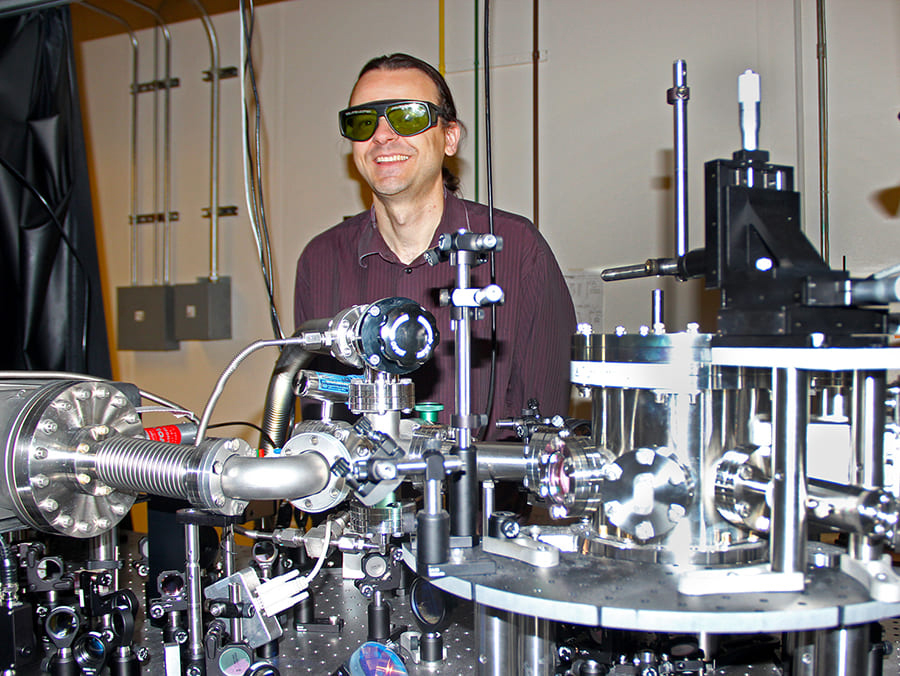While some might think everything is known about gravity and matter, scores of scientists around the globe continue the search for the unexplained mysteries of the universe, and the College of Science's Andrew Geraci is no exception.
One difference though, is many of those scientists are theoretical physicists, scribbling on white boards and running computer models, while Geraci is an experimental physicist using delicate, sensitive precision instruments. He, like other scientists around the world, continues and builds on the works of Isaac Newton, Max Planck, Albert Einstein and others, seeking new ways of understanding the world and the universe.
"We're pursuing big fundamental questions with small-scale experiments, not like the massive particle colliders or big, high-volume dark matter experiments, not just slamming particles together to see what happens," he said. "We're looking for new, exotic forces between particles on a much smaller scale, with short distance gravity experiments. There are unanswered questions about how gravity works."
The Large Hadron Collider is almost 17 miles around and is the world's largest particle accelerator.
In 2013 Geraci proposed a nanodevice that would levitate an invisible-to-the-eye particle so the behavior and motion of particles could be described in quantum limits. The device is now built, and he and his team are conducting experiments in the dust-free, temperature-constant environment on a vibration-insulated tabletop. Geraci's device sits in a basement lab in the physics building on the tabletop with a series of mirrors that transmit a laser beam to the minuscule vacuum chamber where the tiny particle is levitated by a framework of light. The object that receives the laser flash is small, less than a millionth of a meter across.
"It's hard to describe how small the forces are that we study, but if you take the weight of a virus, divide it by 100, that's what we work with," he said. "Or, it's 10 billion times smaller than what can be seen with an atomic-force microscope that's used to image atoms."
"They're looking for big, energetic reactions in high-energy machines, while we're looking for small, exotic new forces due to ultralight matter, forces other than those we already know: strong force, the binding of nuclei; electromagnetic force; weak force; gravitational force," Geraci explained.
While most of his research funding in his quest to find ultralight matter comes from the National Science Foundation, he was recently granted $625,000 from the prestigious Heising-Simons Foundation, a family foundation based in Los Altos, California that promotes fundamental research, primarily in the physical sciences, that has the potential to "innovate, elevate and revolutionize humanity's knowledge and understanding of the universe."
The foundation is supporting his work on zeptonewton force sensing, searching for new extremely small forces between particles. His team of twelve - undergraduate students, graduate students and postdoctoral students - is now working to move a weight past a bead at a distance of five microns to measure the gravitational attraction between objects. His machine can detect forces of a few billionths of a trillionth of a newton.
In addition to investigating limits of quantum mechanics of levitated particles and sensing zeptonewton forces, Geraci collaborates with others in the College of Science as they all seek to solve unanswered questions. In another experiment, he is searching for an exotic ultralight particle called the axion, which if discovered could help explain the lack of charge separation seen in the neutron. He works on dark matter detection, gravitational wave detection, interactions between laser-cooled atoms and micro-mechanical oscillators, optical physics and optical-cooling, as well as investigating new resonant sensors for axion detection.
"Our experiments are lab-based, such as determining a force mediator with new exotic forces between materials," he said. "Most theorists aren't familiar with the small-scale fundamental physics experiments we do, so we try to interact with them, to give them ideas and to get ideas from them.
"Theorists help us figure out what are the good questions. We address these questions, and we devise new techniques." Geraci came to the University in 2011 after conducting postdoctoral research at one of the nation's longest-operating physical science laboratories, the National Institute of Standards and Technology, for several years. He earned his doctorate in physics from Stanford University in 2007.
"The questions of how the world works, that's what gets me up in the morning, gets me to the office every day," he said. "A lot of mysteries of the universe are staring right at us that we can't see, that need to be discovered."














